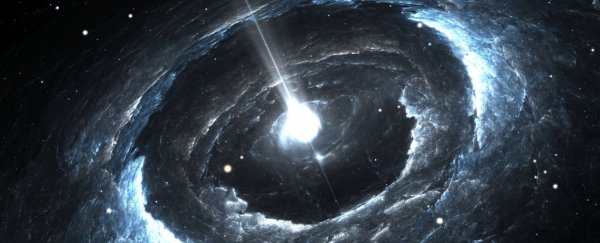A newly discovered source of repeating fast radio bursts has deepened the mystery of what, precisely, could be producing these powerful outbursts.
The source, first detected in 2019 and named FRB 190520B, seems to be frequently spitting out millisecond bursts of powerful radio waves.
This has allowed astronomers to perform analyses that reveal information about where it comes from in the Universe, and the space around it. Those analyses suggest that there is probably more than one mechanism in the big wide cosmos capable of producing these strange outbursts.
Fast radio bursts (FRBs), as the name suggests, are very fast bursts of radiation (lasting only milliseconds in duration) that flare brightly in radio wavelengths.
Most of them come from other galaxies (only one source has been detected in the Milky Way), and they're extremely bright, discharging as much energy in an instant as 500 million Suns.
Most of these outbursts have only been detected once: They come out of nowhere, burst once, then we never see them again. This makes them largely impossible to predict, and very difficult to trace and study.
But a few sources (well, three now) have been detected repeating, and they offer a tantalizing opportunity to understand what's going on. Maybe.
The FRB detected in the Milky Way came from a type of dead star called a magnetar, which suggests that at least some FRBs are caused by magnetar eruptions. But there are still a lot of unknowns.
"Are those that repeat different from those that don't?" says astrophysicist Kshitij Aggarwal from West Virginia University.
The discovery signal from FRB 190520B arrived at Earth in May of 2019, detected by the Five-hundred-meter Aperture Spherical radio Telescope (FAST) in China, and found in the data in November of that year.
Follow-up observations of the location in the sky revealed that the source was repeating.
More observations were conducted using the National Science Foundation's Karl G. Jansky Very Large Array, revealing a fascinating set of characteristics. The signals were coming from the outskirts of a very old dwarf galaxy, nearly 4 billion light-years away.
Between radio bursts, the source seems to be beaming out weaker radio emission. This suggests that the fast radio bursts are coming from a compact persistent radio source, the nature of which is unknown.
If you're a fast radio burst aficionado, this might sound familiar. That's because those characteristics are shared with another famous repeating fast radio burst, FRB 121102.
This was the first FRB ever traced to a source, the outskirts of a very old dwarf galaxy 3 billion light-years away. And it, too, is associated with a compact persistent radio source.
"Now we have two like this, and that brings up some important questions," says astronomer Casey Law of Caltech.
We don't, for example, know whether one-off FRBs are repeating at energies too low for us to detect. But scientists have thought for some time that there may be at least two different mechanisms for producing the bursts, and the discovery of FRB 190520B is consistent with this idea.
This could either mean that the different bursts are emitted by different objects, or emitted by the same kind of object in different stages of its evolution.
Magnetars are a type of neutron star – the collapsed, ultra-dense core of a massive star after it has gone supernova and died – but they also feature an extremely powerful magnetic field. It's possible that normal neutron stars and magnetars emit FRBs in different ways.
Further analysis suggests that another feature of fast radio bursts may not be as useful for measuring the Universe as astronomers may have thought.
This feature is called the dispersion measure, and it has to do with how light is scattered by tenuous gas in the space between us and the source. Higher-frequency waves travel more efficiently than those of lower frequency, and this can be used as a guide to measure distance.
For FRB 190520B, the dispersion measure suggests that the source is 8 to 9.5 billion light-years away. Independent measurements of the distance, however, show that the galaxy is not that far.
"This means that there is a lot of material near the FRB that would confuse any attempt to use it to measure the gas between galaxies," Aggarwal says. "If that's the case with others, then we can't count on using FRBs as cosmic yardsticks."
On the other hand, this suggests that the persistent radio source emitting the FRBs resides in a very complex plasma environment, consistent with the characteristics of a recent super-luminous supernova. This suggests that whatever the source is, it formed very recently – a 'newborn' FRB source.
"We further postulate that FRB 121102 and FRB 190520B represent the initial stage of an evolving FRB population," says astronomer Di Li of the National Astronomical Observatories of the Chinese Academy of Sciences in China, who led the research.
"A coherent picture of the origin and evolution of FRBs is likely to emerge in just a few years."
The research has been published in Nature.
